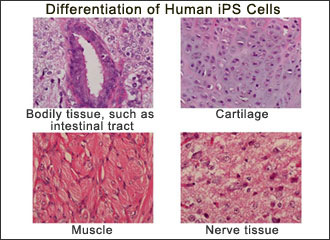|
REGENERATIVE MEDICINE MOVES A STEP CLOSER
Pluripotent Cells Created from Skin Cells
(February 14, 2008)
|
|
In a breakthrough that was hailed around the world, a team led by Professor Yamanaka Shinya of the Institute for Frontier Medical Sciences at Kyoto University has successfully developed induced pluripotent stem cells (iPS cells), which have almost the same abilities as embryonic stem cells, from human skin cells. By introducing three or four types of genes, skin cells can be changed into iPS cells, which can, in turn, become other kinds of cells that may be useful in regenerative medicine. 
(C)2008 Japan Echo Inc. Method Avoids Ethical Problems It may be possible to regenerate or restore internal organs using the technology for creating iPS cells. And if such cells can be cultivated outside the body and differentiated to produce cardiac muscle cells or liver cells, for example, they may be useful in drug development and testing the side effects of individualized drug treatments. The potential applications for this technique are wide ranging. 
(C)The Institute for Frontier Medical Sciences, Kyoto University The Japanese government reacted quickly to the announcement, which is said by some to be significant enough to merit consideration for a Nobel Prize. On November 28, at the General Science and Technology Conference, the prime minister indicated his intent to consider ways to support the research. At a press conference on December 18, Minister of Education, Culture, Sports, Science and Technology Tokai Kisaburo asserted the need to establish a center at Kyoto University for the promotion of this research, including clinical studies. The Japan Science and Technology Agency (JST), which has until now been the source of research funding, on December 25 hosted a symposium on the theme "The Future of iPS Cell Research" and resolved to increase funding by several hundred million yen within the current fiscal year to support measures for securing intellectual property rights, acquiring human resources, and other tasks. On December 22, the Ministry of Education, Culture, Sports, Science and Technology announced plans to invest approximately ¥2.2 billion ($20 million at ¥110 to the dollar) in iPS-cell-related research in fiscal 2008 and a total of ¥10 billion over five years. A nationwide system is to be established through the formation of an iPS Cell Research Consortium, which will have a membership of researchers from across Japan, with the research center at Kyoto University serving as the core facility. The announcement by Professor Yamanaka's team coincided with a similar one by a team from the University of Wisconsin in the United States. And a team from the Massachusetts Institute of Technology announced in the December 7 issue of Science magazine that they had succeeded in improving symptoms of anemia in mice using hematopoietic stem cells created outside the body from iPS cells. A number of other research institutes are also undertaking research using iPS cells. There is growing momentum in various countries behind this research. The ultimate goal of all those involved is for the research results to be applied to improve the lives of patients. |
Copyright (C)2008 Web Japan. Edited by Japan Echo Inc. based on domestic Japanese news sources. Articles presented here are offered for reference purposes and do not necessarily represent the policy or views of the Japanese Government.